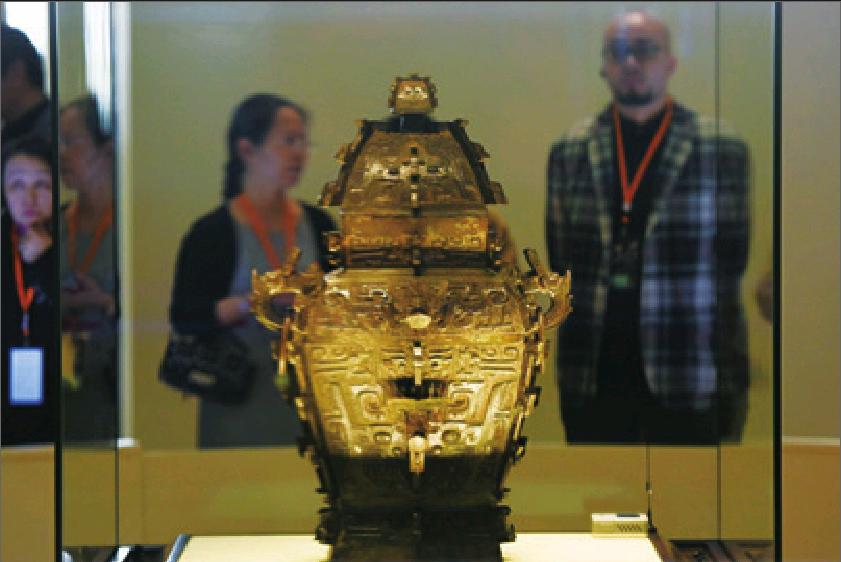Chinese Art Finds Its Way Home
2015-12-14ByCorrieDosh
By+Corrie+Dosh

Willard Straight and his wife, Dorothy Payne Whitney Straight, were quite the glamorous couple. Married in 1911, the self-made millionaire and his stunning wife took a honeymoon train ride from Geneva to Peking, settling into an apartment near the Forbidden City to expand their growing collection of ancient Chinese art and artifacts “rescued” from temples being plundered by vandalists.
The American couple returned to New York City with a treasure trove of statues and scrolls, outfitting the rooms of their patron foundation, the Asiatic Institute, headquartered in a building formerly used as the New York Cotton Exchange, known as “the India House.” Their collection would help inspire American and British museums to shore up their own collections of Chinese art.
Willard Straight, a career diplomat who had been appointed a consul general in China by his friend, U.S. President Theodore Roosevelt, had even gifted valuable pieces that are still on display around the world, including in The Hague and the White House. It was a time of“cultural diplomacy” when art was taken from the ancient world in the name of preservation. Now, these treasures are finding their way back home into the collections of Chinese families who made their fortune in the new economy.
The millionaire philanthropists
Margaret Stocker, a trustee of the India House Foundation (founded by the Straights), is writing a book about the Asian and maritime art that was housed at the foundation. In Saving Chinas Art: The Heiress, the Diplomat and the ‘American Emperor, Stocker gives a glimpse into the world of the U.S. cultural elite of the early 20th century, who had the means and desire to explore the farthest reaches of the globe at a time when the world was just starting to connect and expand.
In Stockers book, the Straights are the titular heiress and diplomat, while President Roosevelt is known as the “American Emperor.”The three collaborated to raise awareness of Asian art through the Asiatic Institute.
“Dorothy and Willard Straight were really ahead of their time to object to the destruction of art for the sake of adding it to a museum,”Stocker said at a lecture hosted by the Renwen Society at the non-profit China Institute and the Confucius Institute for Business in New York City, “but the ethics of collecting art in one country and taking it to another is very difficult.”
In the early 1900s, however, the trade of ancient art and cultural artifacts was seen as an impetus for world peace. “They believed that trading partners are unlikely to wage war on one another,” Stocker said, adding that Roosevelt was the first U.S. politician to broker a truce between two foreign powers, earning him the Nobel Peace Prize.
Fueling the trade of ancient art was the thriving maritime shipping industry, driven by the oil barons and captains of industry in an increasingly prosperous America.
“In 1913, Dorothy and Willard Straight expanded on Roosevelts foreign policy by adding‘cultural diplomacy as a tenet. Each and every ship captain and crew trading in a foreign port naturally became purveyors of culture, introducing native language and customs and bringing back the stories, language and customs they encountered on their journeys,” Stocker said. “The Straights built on this exchange of culture by creating a utopian program to ‘save Chinas art.”
Up for auction
Over the past two decades, the treasures of the India House have been sold off, piece by piece, in auction. In 2011 a bronze statue sold at Christies auction house in New York for $2.21 million, and a dozen vessels and statues were sold off in 2014 for hundreds of thousands of dollars each. Traces of the Straights influence remain at the India House, with walls trimmed with scallop decor and maritime influences, and a small collection of Buddha statues and opium pipes. Most of the items are auctioned off to a new wave of collectors—Chinese business executives and entrepreneurs who have newfound wealth, according to Angela McAteer, Vice President and head of the Department of Chinese Works of Art at Sothebys, New York.
Evidence of this trend is everywhere. Sothebys garnered more than $24 million in sales at its Asian art auction in September, also held in New York. The Chinese and Asian art on offer was led by “Monochrome”: a concept sale that blended traditional and modern Chinese works in a shared aesthetic of clean lines and subtle variations in color. The pieces achieved prices well in excess of their projections, said organizers, including a vase that sold for $706,000, but was originally estimated at $150,000-$200,000.
The highlight of the auction was a rare imperial bronze bell made for the court of an emperor in the late 1700s. Acquired by U.S. publisher William Randolph Hearst, the bell was originally one of a set of 16. Only three bells remain and Sothebys sold Hearsts piece for more than $1.2 million.
Last spring, Christies had its biggest week of Asian art sales ever, hauling in $161.1 million with the sale of the Robert Ellsworth collection. Ellsworth, a private American collector, assembled one of the greatest collections of Chinese art in the world, including Qing Dynasty (1644-1911) ceramics, furniture and paintings.
Typically, collectors of these ancient artifacts tend to be the nouveau riche emerging out of China who have made recent fortunes. These collectors are attracted to the value and the historical nature of these works, and are increasingly sophisticated, said Harold Yeo, Assistant Vice President of Sothebys, New York. Sothebys CEO Tad Smith told U.S.-based TV broadcaster CNBC that while buyers are becoming more “discerning” and “careful” about what they buy, they are still bidding big bucks for the best pieces.
Demand for traditional Chinese art has remained strong despite the volatility in Chinas stock market this year. Christies announced that buyers from the Chinese mainland increased their spending on global art by 47 percent in the first half of 2015. Sothebys reported that Chinese buyers spent 51 percent more during its summer sales in London and that Asian buyers competed for 30 percent of the lots offered at its spring evening sale.
“All of our clients are stepping up to buy things they really want that are high-quality items that are fresh,” Smith said. “They are being more careful on where they spend and focusing on what they really want rather than the things they might have wanted when they felt a little more flush.”
Perhaps many of these buyers feel a sense of pride in returning priceless Chinese artifacts back to their homeland. It is this sense of justice that prompted users of Sina Weibo, a popular Chinese microblogging service, in 2013 to demand the return of priceless artifacts looted by the British in the 19th century. When British officials invited Weibo followers to ask questions of UK Prime Minister David Cameron on a state visit, the site was inundated with calls to return some 23,000 items in the British Museum, which were taken by the British army.
Like Willard and Dorothy Straight, collectors of ancient Chinese art have often seen themselves as preservationists and protectors. But as the buying power of many Chinese collectors increases, many of the pieces originally taken abroad will now return to their native culture to stay.
